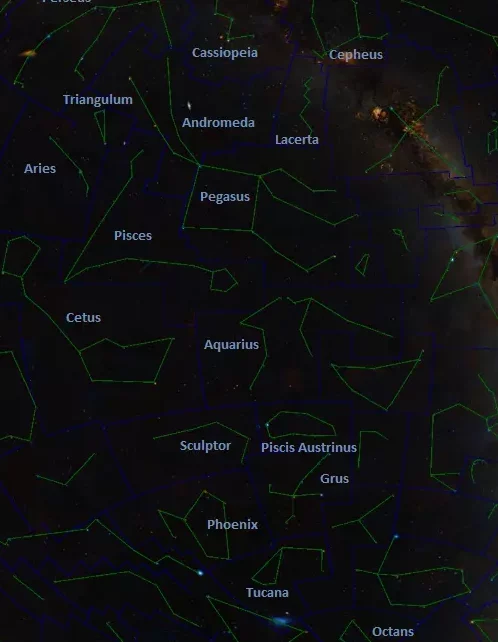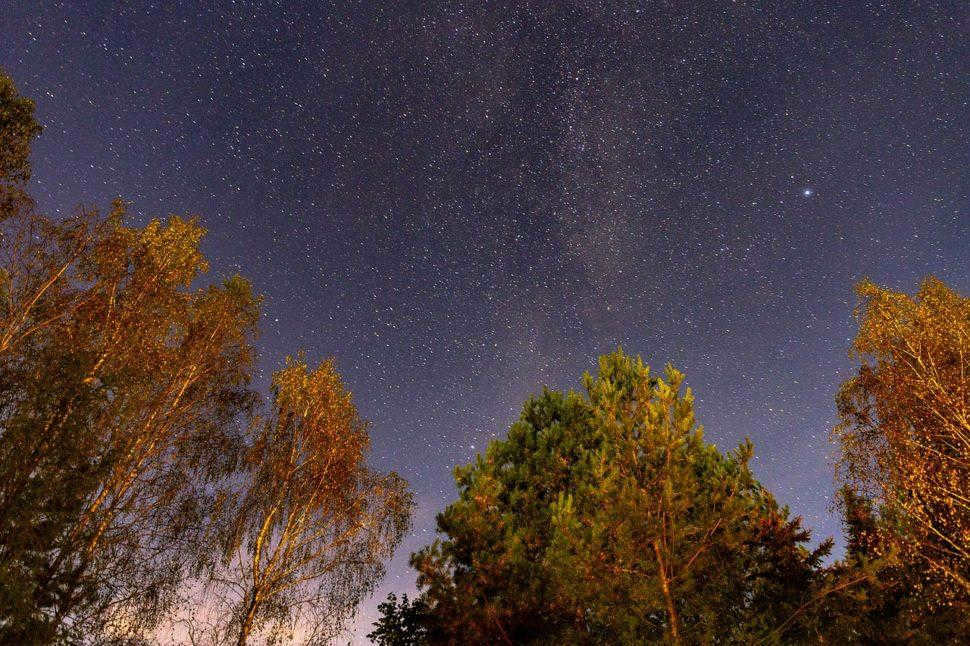
The length of the night is increasing and the duration of the day is decreasing as we move into October, following the autumnal equinox. As a result, the sunrise is becoming progressively later. Furthermore, October brings about a change in the constellations that are visible in the night sky, replacing those of the summer months. According to astronomers, the dominant constellations in October include Aquarius, Cepheus, Crane, Lizard, Octanthus, Pegasus, and South Fish. Throughout the night, the constellations Lizard, Aquarius, and Pegasus can be seen in the southeast, with Pegasus being particularly useful in locating the Andromeda Galaxy.
Constellations in the Autumn Sky
Below is a table showing the names of the constellations visible in the autumn sky of both the Northern and Southern Hemispheres, organized by month.
The positioning of the constellations in the sky is indicated as follows: C – Northern Hemisphere; S – Southern Hemisphere; E – Equatorial region
September ConstellationsOctober Constellations
November Constellations
| Eagle (E) | Aquarius (E) | Andromeda (S) |
| Capricorn (S) | Cepheus (S) | Cassiopeia (C) |
| Swan (C) | Crane (S) | Phoenix (S) |
| Dolphin (C) | Lizard (C) | Fish (E) |
| Small Horse (C) | Octanthus (Y) | Sculptor (Y) |
| Indian (S) | Pegasus (S) | Toucan (Y) |
| Microscope (Y) | South Fish (Y) | |
| Peacock (S) | ||
| Arrow (C) | ||
| Fox (C) |
What celestial formations are visible in October
October typically presents unfavorable weather conditions for those who enjoy stargazing. The sky is often veiled by thick layers of clouds, obscuring constellations and stars. Only the radiant Moon manages to break through the overcast sky with a faint glow. However, on the rare occasions when the nights are clear, one yearns to dedicate as much time as possible to observing the mesmerizing expanse of the night sky. So, what celestial formations can be admired during October nights, either with the naked eye or with the aid of optical instruments?
Near the highest point in the sky is the constellation Cassiopeia, which has a resemblance to the letter “W”. Just slightly below and to the left, in a northwesterly direction from Cassiopeia, you can find the constellation Cepheus.
The Summer-Autumn Triangle is positioned in a westward slope, but it still remains relatively high above the horizon line, making it perfectly visible. Moving to the right of Lyra, you will come across the constellation Hercules as it approaches the sky. Above Hercules, you will find the Dragon’s Head. The Big Dipper can be seen rising slightly east of the northern side of the horizon, with the Little Dipper located above it.
When looking towards the east, you will be able to spot the constellation Gemini. Just below Gemini, near the skyline, you should be able to see the constellation Little Dog and its bright yellowish star, Procyon.
Heading South
When you look south of Cassiopeia, you will find the majestic Andromeda constellation above, and below, near the southern part of the sky, you can spot the magnificent Whale constellation. If you turn to the right (west) of Andromeda, you will be able to see the graceful Pegasus.
If you direct your gaze southeast, close to the horizon, you will discover Orion, with Taurus above it, and Perseus even higher in the sky. On the left side of Perseus, you will find the Ascendant constellation.
It is worth noting that the sky will be adorned with two meteor showers in October: the Draconids from October 8th to 10th, and the Orionids from October 21st to 22nd.
What other celestial wonders await us on the starry canvas in October? Which constellations and stars will illuminate the mid-autumn nights?
The Lizard constellation
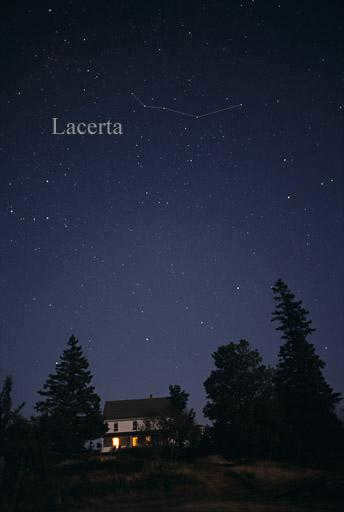
Residents of the Northern Hemisphere of the Earth have the privilege of observing this constellation. It can be easily spotted by aligning oneself with Andromeda. Although the constellation of the Lizard consists of 60 stars, none of them are particularly bright. Nevertheless, it is visible without much effort, as long as one waits for the darkest sky possible.
Discovered in 1600 AD, the Lizard constellation is considered relatively “young”. It is often referred to as Lacerta, the Latin translation of its name. Resembling the letter “W”, the Lizard constellation covers only 200 square degrees. It ranks as the 68th largest constellation among the 88 constellations known. The Lizard does not contain any galaxies, only star clusters.
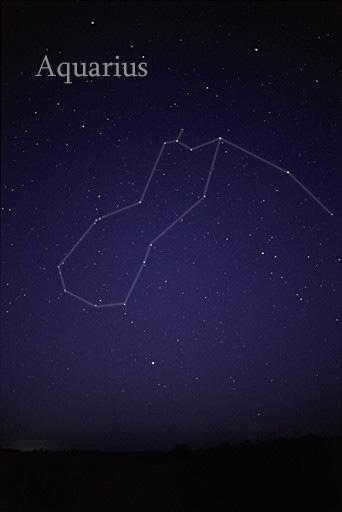
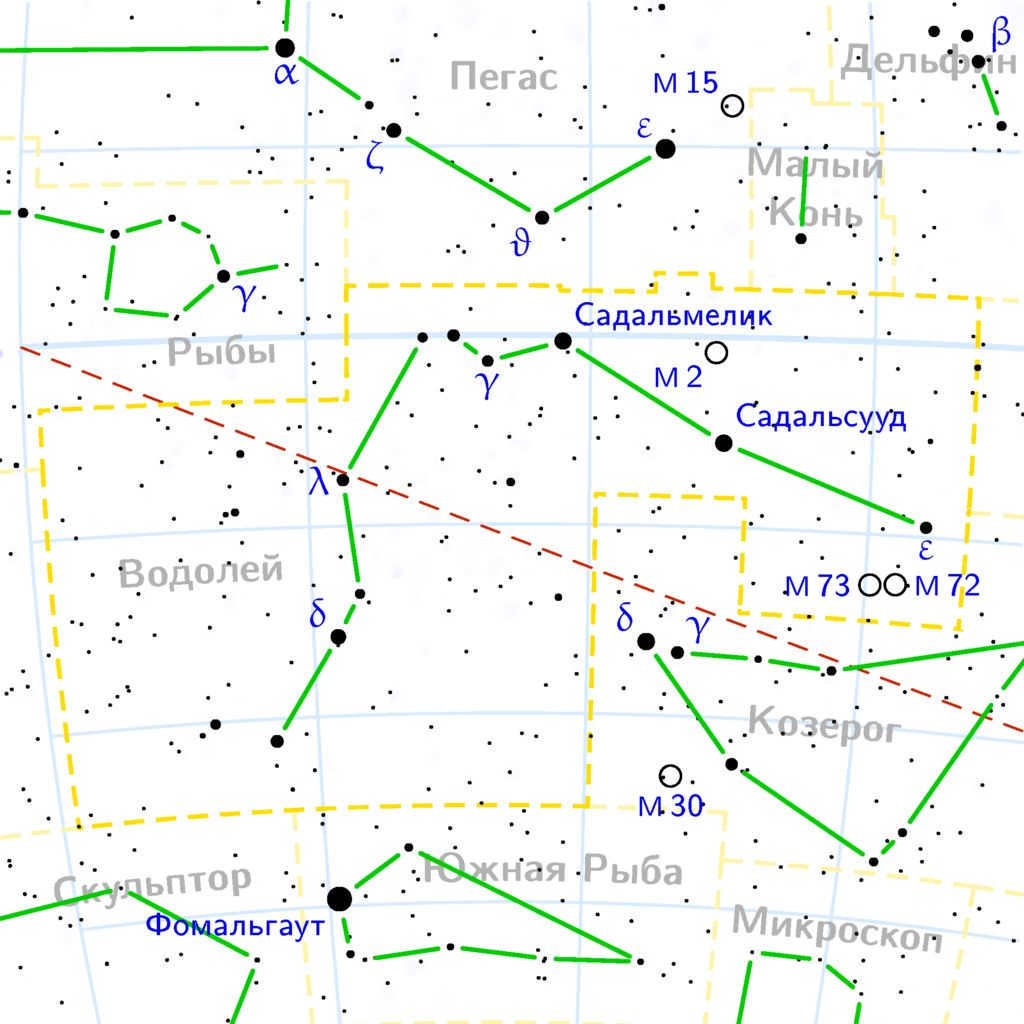
It is situated in the northern region of the celestial dome. During autumn, the constellation can be observed in the Northern Hemisphere, and during spring, it can be seen in the Southern Hemisphere.
In terms of its size, the Aquarius constellation covers an area of 980 square degrees, and it is comprised of 90 or more stars. In terms of magnitude, Aquarius is ranked 10th among the other constellations.
Within the celestial sphere, there is a designated area known as the “water” section, which includes constellations like Aquarius, Whale, Dolphin, and Fish.
The Pegasus constellation
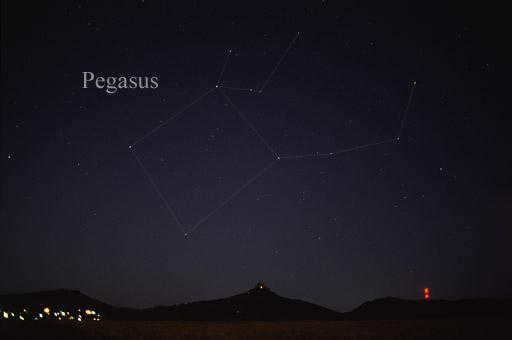
The Pegasus is a legendary creature from ancient mythology that was depicted as a magnificent white horse with enormous wings, enabling it to gracefully glide through the sky.
When observing the Pegasus constellation, it is evident that only the upper part, including the body and wings, is represented, with the absence of legs. The sheer size of this constellation is truly remarkable, covering an area of 1121 square degrees. Within its vast expanse, there are numerous galaxies and even a cluster of stars known as a globular cluster. Even without specialized equipment, one can identify over 160 stars with the naked eye.
Pegasus is part of the Perseus constellation family, named after the ancient hero who famously slayed the Medusa Gorgon according to legend.
The constellation Crane
The Crane constellation is a celestial formation that can be observed in the night sky. This group of stars is named after the elegant and graceful bird, the crane. In ancient times, the crane was often associated with attributes such as longevity and wisdom. The Crane constellation consists of several bright stars that form the shape of a crane in flight. Its distinctive pattern makes it easily recognizable to stargazers. The Crane constellation is located in the southern hemisphere and can be seen from various parts of the world. Its beauty and symbolism have captivated astronomers and skywatchers throughout history.
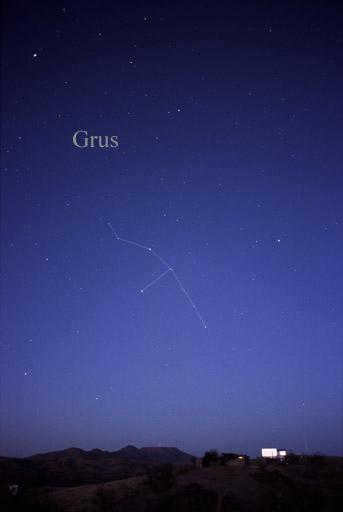
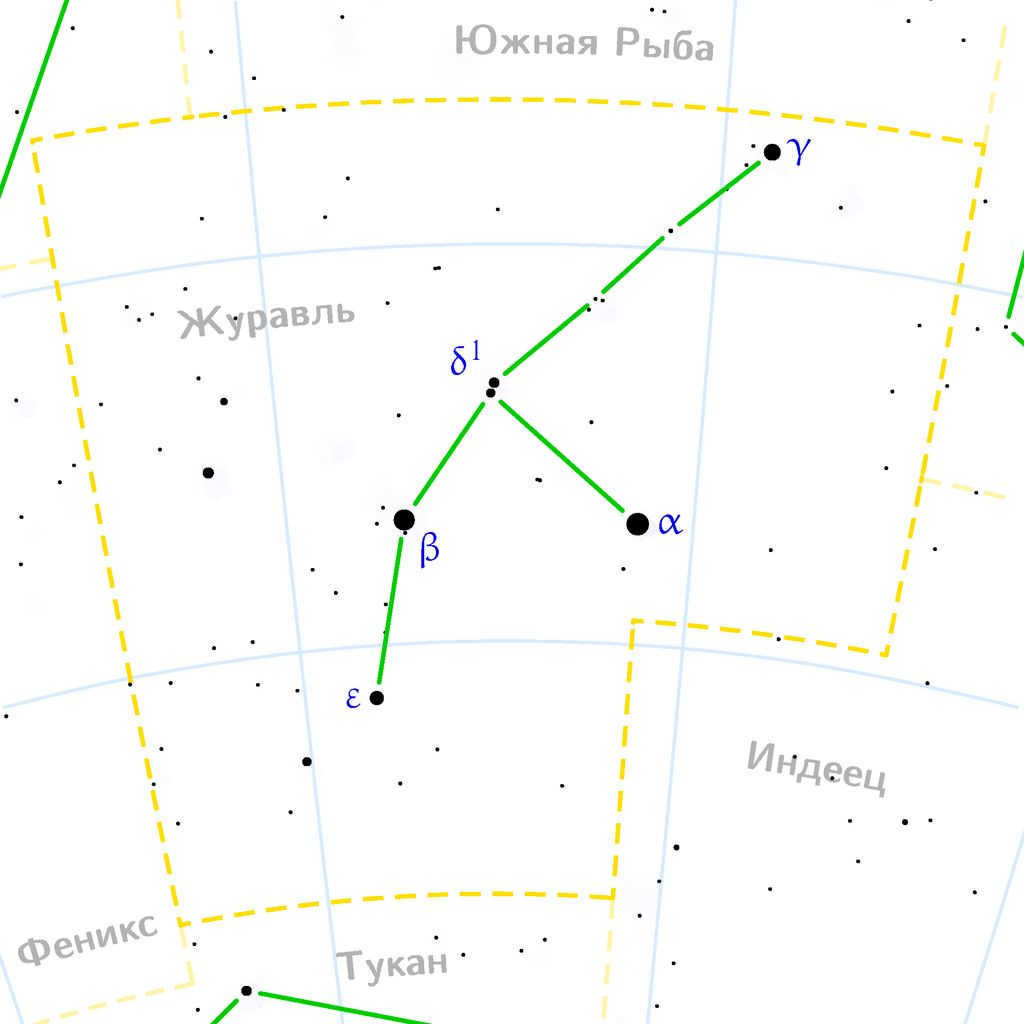
The Crane constellation is situated in the Southern Hemisphere, positioned between Tucana and South Fish. In the Northern Hemisphere, it can only be partially observed up to 53°N. With an area of 366 square degrees, it holds the 45th spot on the list of constellations based on its magnitude. Originally named Flamingo, this constellation was added to the globe in 1598. The best time to observe the Crane constellation is during September and October.
When gazing at this constellation without any aids, 53 stars can be seen. Since its initial discovery, the Crane constellation has played a crucial role in astronavigation.
Octant Constellation
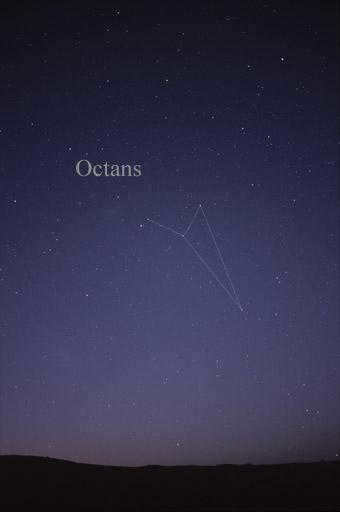
The constellation Octanthus was initially documented in 1754, but it wasn’t officially named until two years later. Eventually, after nearly 9 years, it was given the name Octanthus, which is now well-known among astronomers.
Within the Southern Hemisphere, Octanthus is considered one of the smallest and faintest constellations. It covers an area of only 291 square degrees and is ranked fiftieth in terms of magnitude among all constellations. Only those residing in the Southern Hemisphere have the privilege of observing the Octant constellation. Without the aid of optical equipment, only 35 stars are visible to the naked eye.
Octanthus is positioned south of the ecliptic and has a triangular shape. It is not part of the zodiac constellations and does not have any connections to mythology. One unique aspect of this constellation is that it encompasses the South Pole of the world.

A star shower is always an impressive spectacle, characterized by a burst of meteors disintegrating as they enter the Earth’s atmosphere. Throughout history, people have been captivated by this natural phenomenon. The Draconids and Orionids meteor showers in October were particularly awe-inspiring.
Let’s begin with the Draconids meteor shower, which originates from the constellation Draco. Unfortunately, this shower is quite brief, occurring from October 6th to 10th. The peak of the shower falls on the 8th and 9th, during which time observers in the Northern Hemisphere can witness a high number of shooting stars with reddish and yellow hues.
The speed of the falling meteors during the Orionid meteor shower is relatively slow, averaging around 20 km/h, which is lower compared to other meteor showers. The number of meteor bursts recorded during this event can vary greatly, ranging from 5-15 to 400 or more meteors per hour.
The Orionid meteor shower occurs between October 2 and November 7, with its peak activity happening on October 21-22. This meteor shower is caused by the debris left behind by Halley’s Comet, which is one of the most famous comets in the world. The meteors can be seen in the region of the Orion constellation.
In some years, the number of falling meteors during the Orionid meteor shower can reach as high as 50-70 per hour. Unlike the Draconid meteor shower, which is limited to the Northern Hemisphere, the Orionid meteor shower can be observed in both the Northern and Southern Hemispheres.
Summing it up
This is the essence of an ordinary October sky. The chance to witness different constellations and celestial events is truly invaluable. Although not everything may be visible depending on your location, and the naked eye may not be able to see certain stars, this should not diminish your enthusiasm for stargazing.

The autumn months of October and November provide the perfect opportunity for observing the night sky. With longer nights and milder temperatures, it’s an ideal time to spend more time outdoors and indulge in stargazing. During this period, stargazers can enjoy the captivating beauty of constellations such as Pegasus and Andromeda, as well as the radiant star Arcturus in the Volopassus constellation. Additionally, the Big and Little Bears, which are among the most recognizable constellations in the northern hemisphere, can be easily spotted.
Constellations in the Autumn Sky
Here is a list of the constellations visible in the autumn sky, both in the Northern and Southern Hemispheres, organized by month.
The positions of the constellations in the sky are indicated as follows: C for Northern Hemisphere, S for Southern Hemisphere, and E for the Equatorial Region.
Which constellations are visible in November
The night sky in November is truly stunning. On a crisp, chilly night in the final month of autumn, you can witness the brilliance of the winter constellations illuminating the sky.
Looking North
After midnight in November, the constellation Leo, with its brightest star Regulus, becomes visible above the eastern horizon. The famous Big Dipper can be seen high in the northeastern sky. Towards the northwest, near the horizon, you’ll find the constellations Lyra and Cygnus, with the stars Vega and Deneb shining brightly.
Southern direction
Above the southern region of the celestial sphere, near the zenith, one can marvel at the splendor of the constellation Perseus. To the left of Perseus lies the constellation Ascendant, while below it is Taurus. Further down and to the left, one can spot the constellation Orion with its brilliant stars – the red Betelgeuse and the bluish Rigel and Bellatrix. Gazing towards the southwest, one can observe the constellations Pegasus and Andromeda, with Cetus appearing near the horizon. In the high southeast lies Gemini, followed by the Lesser Dog and its prominent star Procyon. Above the horizon, one can find the brightest star in the night sky, Sirius (α of the Big Dog).
Despite the chilly temperatures, the November night sky offers a spectacle worth witnessing. Below, you will find examples, descriptions, photos, and diagrams of some remarkable constellations and stars that can be observed in November.
The Story of Pegasus and Andromeda

Pegasus, the most ancient known constellation, has a square-like shape. It derives its name from a mythical creature, a horse with wings, in Greek mythology. It can be observed in the night sky between the months of May and December. However, during October and November, it appears higher in the sky than usual and moves towards the east, gradually shifting southward during the late hours of the night.
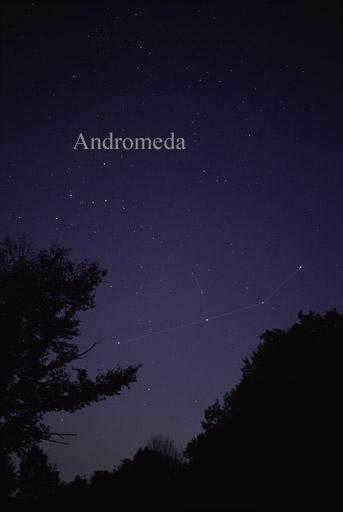
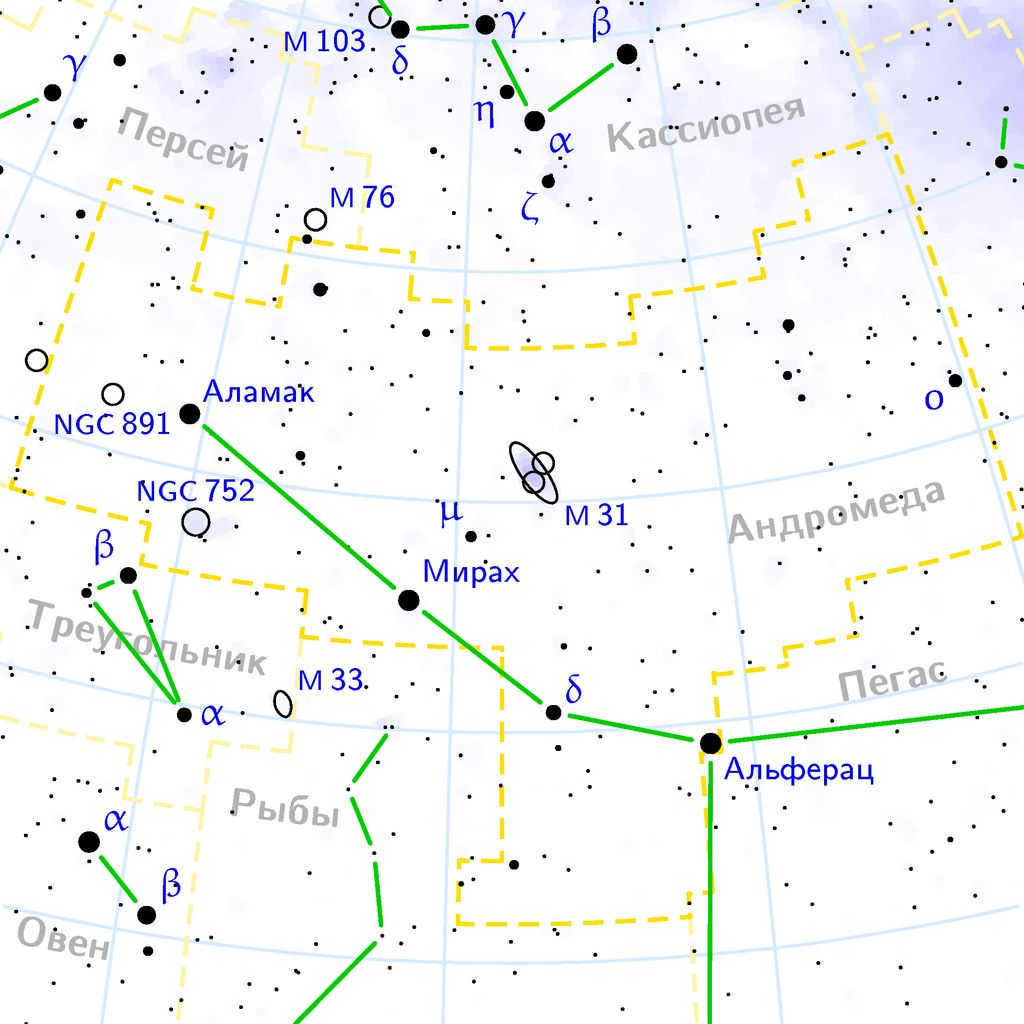
Around 10:00 PM, take a look towards the northeast of the impressive Pegasus constellation. The most luminous star, Alferats, is part of the Andromeda constellation, and from there you can see lines of stars that are not as bright. This constellation can be easily seen in Russia. It is the 19th largest constellation in the sky.

One other remarkable entity in the autumn sky is the Andromeda galaxy, which bears resemblance to our own Milky Way but is several times larger. Scientists have estimated that it contains about a trillion stars. To locate this celestial body, one must gaze towards the southern direction, where Pegasus resides, and then look upwards from there. It is possible to spot the star Alpheratz, and to the east of it lies the Andromeda galaxy (M31). The galaxy exhibits a spiral shape.
Perseus
Perseus was a brave hero in Greek mythology. He was the son of Zeus and Danae. Perseus is best known for his slaying of the Gorgon Medusa, whose head he used to turn his enemies to stone. He also rescued Andromeda from a sea monster and married her. Perseus went on many other adventures, including his encounter with the Graeae and the quest for the Golden Fleece. Despite facing many challenges and dangers, Perseus always showed great courage and resourcefulness. He is remembered as one of the greatest heroes of Greek mythology.
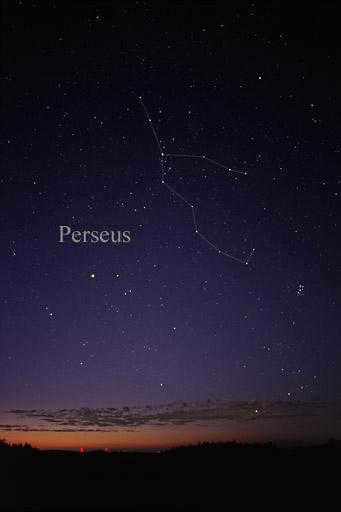
This particular constellation has an intriguing history. Legend has it that a young man named Perseus was the only one capable of slaying the monstrous Medusa Gorgon, thus saving humanity from the dreaded Kraken. In all astronomy guides, Perseus is depicted as a man holding the severed head of Medusa in his hand.
Perseus can be found in the northeastern sky, directly beneath the constellation Cassiopeia, which has the shape of the letter W. Covering an area of 615 square degrees, Perseus is home to approximately 100 stars. The best time to observe this constellation is from the end of August, with optimal visibility in November and December.
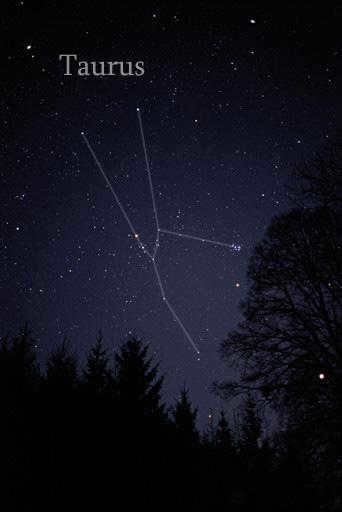
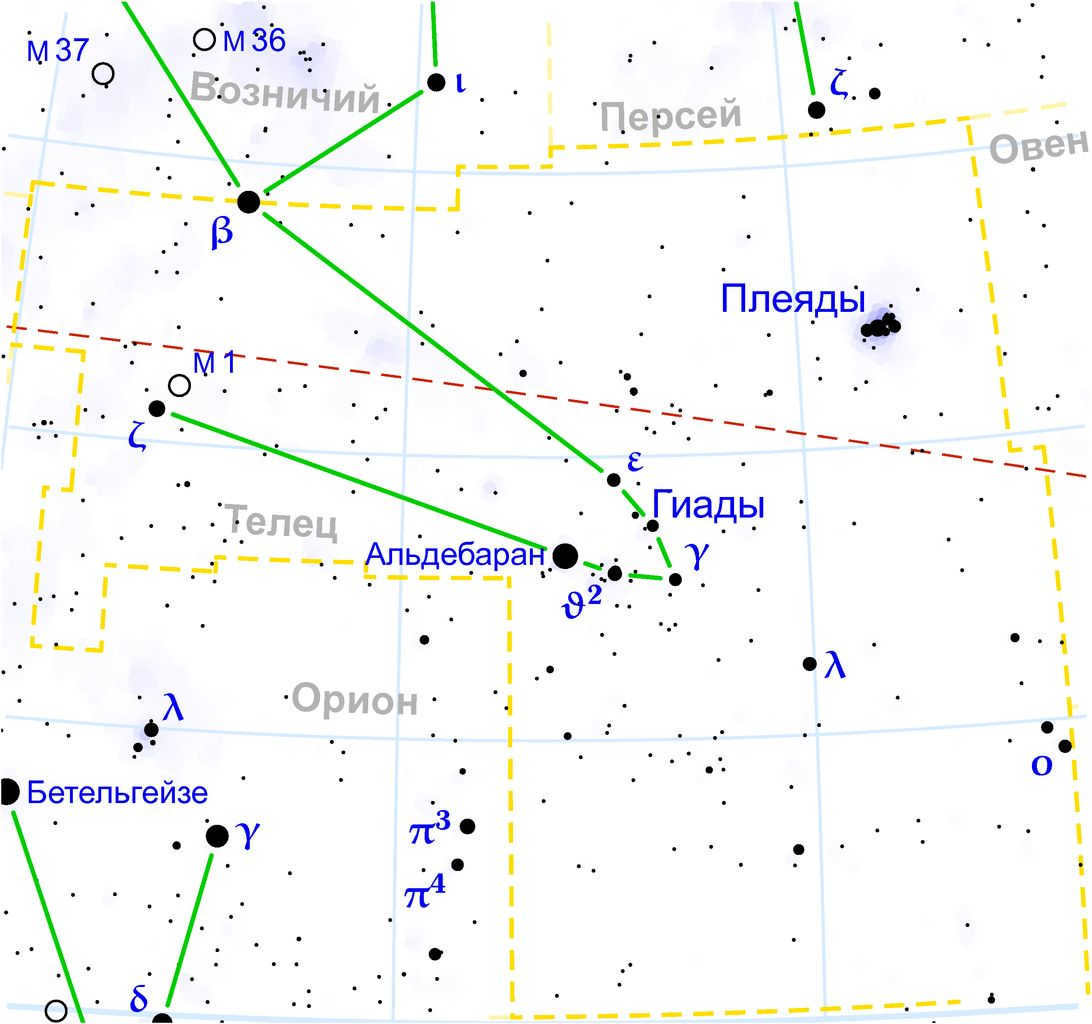
Taurus, a constellation of the zodiac, is a fascinating subject of study for astronomers. Situated near Perseus, it covers an area of 797 square degrees, ranking it 17th in size. Resembling the head of a bull, Taurus is associated with the ancient myth of Hercules transforming into a bull to abduct Europa and bring her to the island of Crete.
Finding Taurus is relatively easy if you familiarize yourself with the neighboring constellations. From the East, it is located next to Gemini to the west and Perseus to the north. Visible throughout the country, Taurus can be spotted by looking for the bright orange glow of the star Aldebaran. To enhance your viewing experience, it is recommended to use binoculars or a telescope with a magnification of 25-30 times.
Stars
Stars in the sky during the month of November are truly breathtaking. Let’s explore a few of these celestial wonders:
Alpheratz
Alpheratz is a binary star located in the Andromeda constellation. It shines brighter than its neighboring stars and is situated approximately 97 light-years away from Earth. What makes Alpheratz unique is that it is actually composed of two stars. The larger of the two is a blue subgiant, which is about three times larger than our Sun.
Located on the “abdomen” of Pegasus and the “forehead” of Andromeda, this celestial body was initially extensively described by Ptolemy as “a star positioned in the navel of Pegasus and the head of Andromeda.” Visible to the naked eye and even in faint telescopes, it has been affectionately dubbed the Mercury Star due to its composition of mercury and manganese, along with other alloyed metals. This awe-inspiring entity is estimated to be around 65-70 million years old and spins on its axis at an astonishing speed of 100 kilometers per second.
Arcturus
can be rephrased as
The Brightest Star in the Northern Hemisphere
.
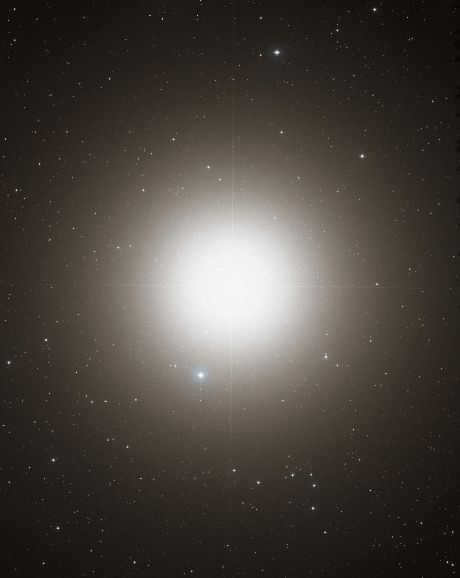
Arcturus, the brightest star in the night sky of the Northern Hemisphere, holds the rank of fourth brightest. A red giant, it boasts an impressive age of 7.5 billion years. It outshines our Sun by 190 times and originates from the constellation Volopassus.
Arcturus becomes visible shortly after sunset, emitting a vibrant reddish glow that is easily discernible. During the winter months, it remains visible throughout the night, while in the summer it can only be seen in the evening. In locations such as St. Petersburg and Moscow, its visibility is limited to around 2-2.5 hours, and it eventually disappears below the horizon in the northwest.
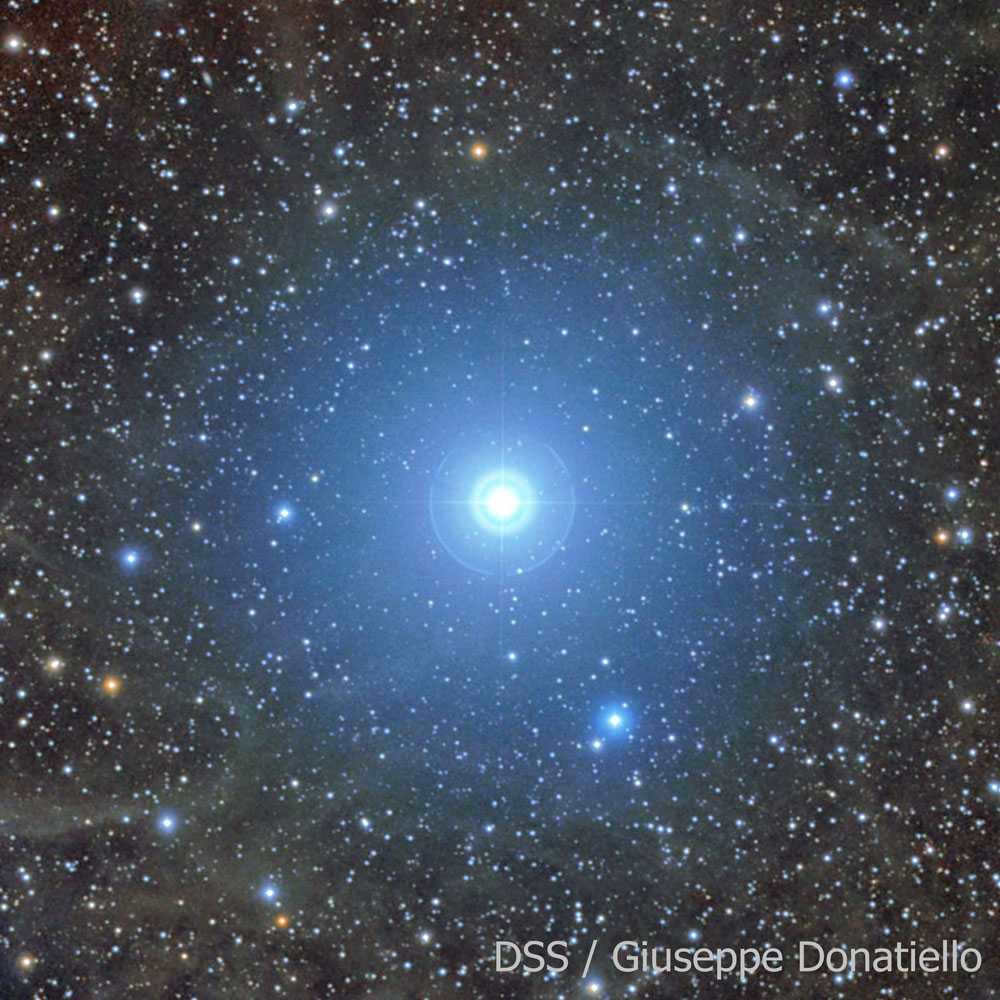
In ancient times, the most renowned celestial body was the guiding star for travelers trying to find their way back home. It is easily identifiable as it is located in the tail of the Little Bear and helps determine the other directions of the world. While it may not stand out much compared to other stars, its uniqueness lies in its ability to accurately point towards the North with only a 1-degree error. While other stars change their positions throughout the year, Polaris remains stationary.
On the opposite side of the hemisphere, there are no stars that can rival Polaris in terms of accuracy. In the present day, it serves as the sole reliable reference point. Polaris is not just a single star; it consists of three stars, one being a supergiant and the other two being smaller in size. Scientists predict that Polaris will eventually cease to be the North Star. Every 100 years, there is a shift of 1.323 degrees, and in approximately 13,000 years, its position will be taken over by Vega, the brightest star in the Lyra constellation.
Sirius
can be rephrased as
The brightest star in the night sky
.
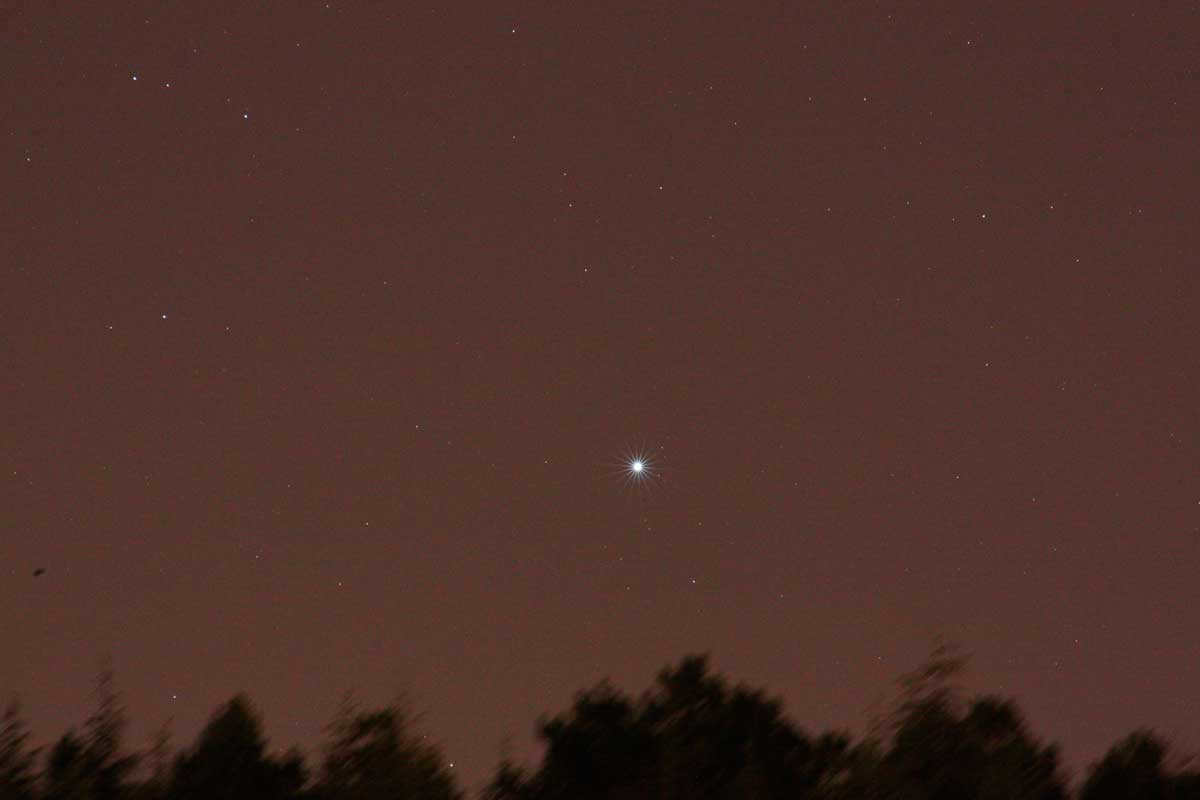
And now, at long last, it is the moment for the most brilliant star in the nocturnal heavens, situated in the southern part of the celestial sphere. During the winter season, it can be observed throughout the entire night, even by the inhabitants of Murmansk, while in autumn it only becomes visible in the mornings. Its distance from our solar system is a mere 8.5 light years, which, in terms of cosmic measurements, is relatively close. In approximately 50,000 years, it will reach its closest point to our solar system, after which it will once again move away.
Sirius can also be spotted during daylight hours when the brightness of the Sun is diminished. It is the most prominent star and much easier to locate.
Paraphrasing
The month of November offers a unique opportunity to observe the sky, as many constellations are better visible and well positioned. The days are shorter, which enhances the brightness of the stars. Unlike the summer and spring seasons, when most stars are not easily noticeable, late fall provides a more comfortable experience for stargazing. The cooler weather and absence of mosquitoes allow one to sit on a bench for extended periods. Contemplating the vastness of the cosmos, one can’t help but wonder about the hidden objects and secrets that lie in the distance, forever beyond the reach of human eyes.
The autumn night sky is a captivating sight. As the days grow shorter in the fall, the sky takes on a mesmerizing frozen effect, particularly during the early evenings of September, October, and November. It’s remarkable that these early evening skies showcase the same star patterns as the summer constellations. Interestingly, the constellations of autumn are actually considered to be summer constellations. They seamlessly replace the summer constellations after midnight when observing the sky in September. By October, these constellations can be seen in the southern part of the sky approximately 3-4 hours after sunset, and by November, they can be observed just 2 hours after dusk. In this article, we will delve into the appearance of the constellations that grace the fall sky.
Displayed below is an image capturing the mesmerizing night sky, which can be witnessed during autumn evenings a couple of hours post sundown in the central region of Russia.
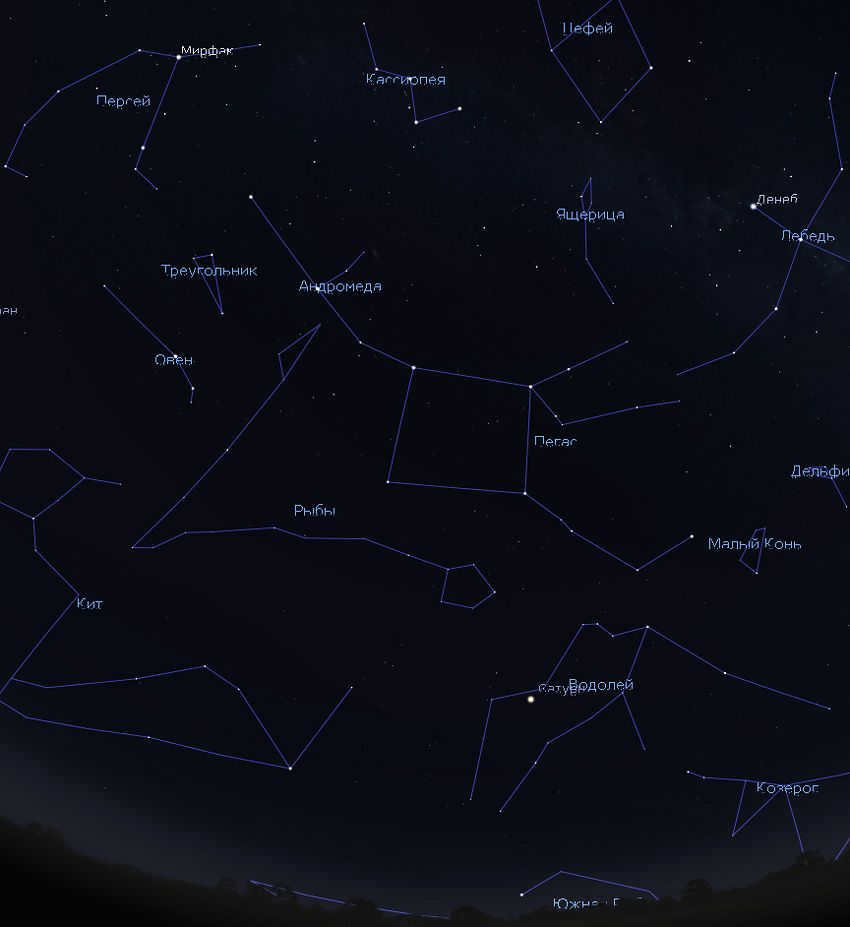
Overview of the constellations that grace the autumn sky. Image: Stellarium
Please note that the autumn constellations may not feature extremely luminous stars. However, the night sky during this season is far from dim, as it showcases a considerable number of stars with moderate brightness. Moreover, the autumn constellations are bordered to the west by the radiant Summer Triangle and to the east by the even more brilliant winter constellations.
The Great Square of Pegasus
One of the prominent features of the autumn night sky is a large square composed of stars of second magnitude. This square can be observed in the southeastern part of the sky during the evenings in September, positioned at an angle. As the fall progresses, it moves higher in the sky and becomes almost parallel to the horizon when viewed from the south. Even in urban areas, the stars that form this square can be easily seen, as they shine with a brightness similar to the stars in the handle of the Big Dipper.
This celestial pattern is commonly known as the Great Square of Pegasus or simply the square of Pegasus.
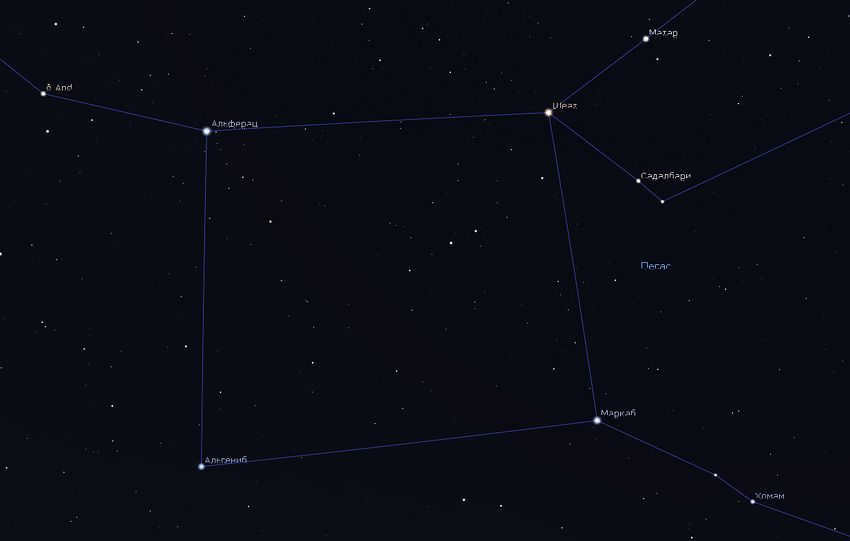
The dominant feature of the autumn night sky is the Great Square of Pegasus. According to Stellarium, this pattern consists of four stars, three of which are part of the Pegasus constellation, while the fourth star is located in the Andromeda constellation. As a result, the Great Square of Pegasus is not considered a separate constellation but rather an asterism.
The square consists of stars that each have their own unique names. Sheath (or the beta of Pegasus) is the star located in the upper right corner of the square. Sheath is classified as a distant red giant and is also an intriguing semi-regular variable star.
The star known as Markab (alpha Pegasus) is positioned in the lower right corner of the square. It is an equally distant white giant of spectral class B9III.
Located in the lower left corner of the square is the star Algenib (Pegasus gamma). Algenib is a hot subgiant with a high luminosity. It holds the distinction of being the most remote star in the quadra, with a distance of approximately 400 light years!
Lastly, the upper left corner is represented by the star Alpheratz (or Alpha Andromeda), which is also a hot B-type spectral star. Its estimated distance is 100 light-years.
The names of the stars in the square have Arabic roots. They have been passed down to us from the Middle Ages, and it is now challenging to determine their exact meanings. For instance, Markab has various translations such as Ship, Wagon, or Saddle. Algenib could derive from Al Janah (meaning wing), but it could also originate from Al Janb (meaning side). And so forth.
Pegasus and Andromeda
The main constellations in the autumn sky are Pegasus and Andromeda. Pegasus consists of the three stars forming the Big Square and approximately twelve stars to its right. (In an urban sky, it is unlikely that you will be able to observe much more.)
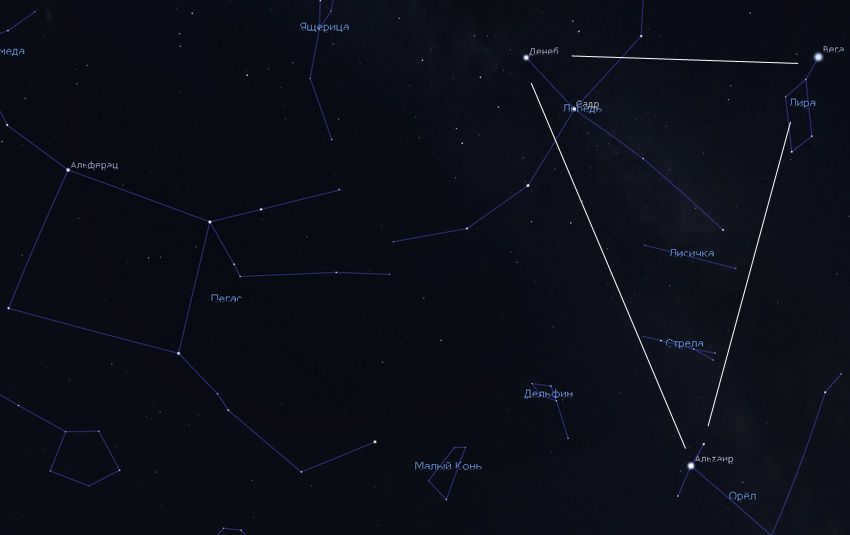
The Pegasus constellation occupies a rather large portion of the sky, stretching from the Big Square in the east to the Summer Triangle in the west. Image: Stellarium
Of particular interest is the relatively bright star known as Epsilon of Pegasus. It can be found to the right of the base of the square, near the Lesser Horse constellation (see image). Normally, its brightness is comparable to that of the stars in the square. However, there are times when its brightness increases significantly, making it the brightest star in the constellation.
Continuing to the right, one can observe the summer constellations. The prominent pattern in this part of the sky is the large summer triangle.
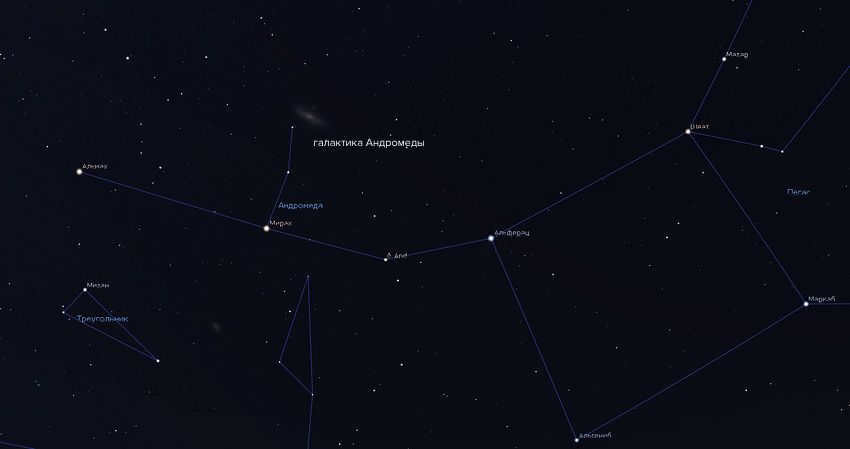
The constellations of the autumn sky. Adjacent to the Great Square to the east is the Andromeda arm. Figure: Stellarium
First in the chain is Andromeda delta, the faintest of them all. Next is the star Mirach, also known as beta Andromeda. Finally, at the end of the handle lies the star Alamac, or gamma Andromeda. Alamac is a stunning double star that can be observed with amateur telescopes. Mirach is of particular interest because it is situated just above the famous Andromeda galaxy. (Learn how to locate it in the sky here.)
There are numerous other stars in the constellation Andromeda, but they are nearly invisible in urban areas. For city dwellers, Andromeda appears as the handle attached to the left side of the Pegasus square, resembling a turkey or a smoking pipe when combined together.
Perseus
If we continue to move Andromeda’s knob further east, we will come across a star that shines slightly brighter than all the stars mentioned earlier. This particular star is known as Mirfak and it holds the position of being the primary star in the Perseus constellation.
Mirfak, also referred to as Alpha Perseus, is located right at the center of the constellation. From Mirfak, we can observe three chains of stars branching out: one going upwards towards the zenith, one going downwards and slightly to the left, and one going almost vertically downwards. When combined, these chains form a shape that resembles an upside-down slingshot or the Greek letter λ. This shape represents the main figure of Perseus.
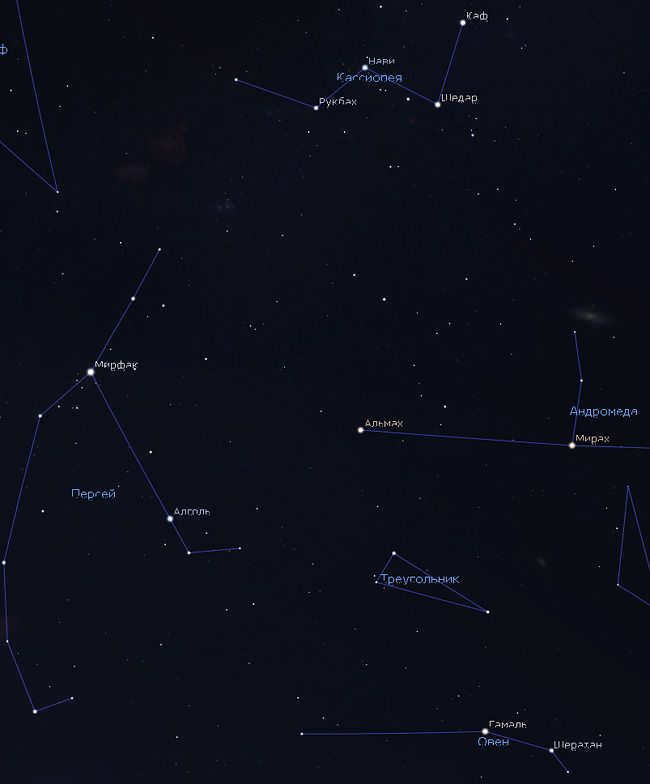
Perseus and Cassiopeia are two constellations that can be seen in the November sky. This information is provided by Stellarium, a software that allows users to explore and learn about the stars and constellations.
Algol, an eclipse-variable star, is the second brightest luminary in the Perseus constellation. It is an interesting star because its luminosity changes. Most of the time, it has a luminosity of 2 m, but every three days, it drops to 3.5 m for a few hours. This means that the star dims more than 2.5 times during this period.
Cassiopeia
A group of stars that stretch upward from the star Mirfak indicates the direction of Cassiopeia. During the autumn evenings, it reaches its highest point above the Andromeda group of stars. Its configuration is easily identifiable as it resembles the letter W in the Latin alphabet.
The constellation Cassiopeia is visible in the Russian sky throughout the year, never disappearing below the horizon. We mention this constellation because it is intertwined with the ancient Greek myth of Perseus, along with Pegasus, Perseus, and Andromeda. However, these are not the only mythological heroes that have been immortalized in the night sky!
The constellations of Pisces, Cetus, South Pisces, and Aquarius
If you reside in an urban area, you will observe a vast expanse of sky devoid of any stars directly beneath the magnificent Great Square of Pegasus. However, on occasion, the Moon graces this expanse, and occasionally the planets make an appearance. This particular region is known as the zodiacal constellation of Pisces.
Pisces can only be truly appreciated in a setting of darkness and a sky devoid of moonlight. Its beauty is truly evident in the complete absence of any illumination. Its primary formation is the asterism Ring and a lengthy, curving chain of faint stars that extend to the east.

The constellations in the autumn sky lack brightness. Therefore, Pisces, Whale, Aquarius, and South Pisces can only be observed in rural areas. Image: Stellarium
Now, let’s return to the square of Pegasus once again. Take the right side of the square and mentally extend it downwards towards the horizon. If you reside at a latitude equal to or below Moscow, you will be able to spot a brilliant star low in the southern direction. This star is known as Fomalgaut, the alpha star of South Pisces. Fomalgaut is sometimes referred to as the lone star due to its significant distance from other first magnitude stars in the sky.
Incidentally, the fall sky’s “water world” doesn’t stop there. Beyond Fomalgaut and the square of Pegasus, on the right side of the Pisces and Cetus constellations, lies Aquarius. This constellation is quite faint, making it challenging to identify any distinct patterns. However, in 2022, Aquarius will be accompanied by a brilliant Jupiter, making it easier to locate in the night sky.
The constellations of Aries and Triangle
Let us now turn our attention to the final autumn constellations. Found beneath the farthest stars of Andromeda’s handle and situated above the constellation known as Keith, we find the constellations of Aries and Triangle.
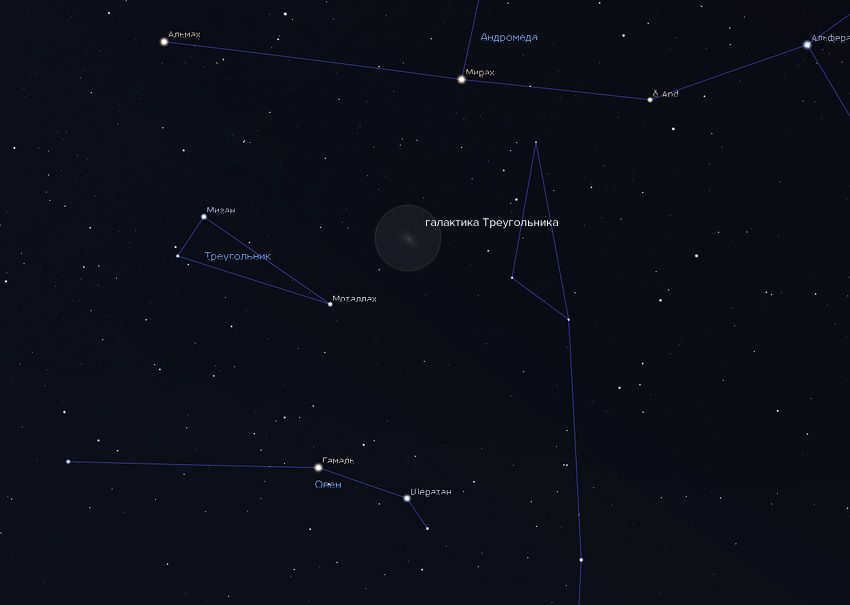
The constellations known as Triangle and Aries can be observed in the autumn sky. The Triangle constellation is easily recognizable as it resembles the shape of a triangle. This particular constellation is of interest because it contains the Triangle Galaxy, also known as M33. The Triangle Galaxy is part of the Local Group of galaxies, which includes the Andromeda Nebula and our very own Milky Way.
Directly below the Triangle constellation is the constellation known as Aries. A prominent star in Aries is Hamal, which can be seen in the night sky even in urban areas. Another notable star in Aries is Sheratan, also known as beta Aries, which is located to the right of Hamal. While the rest of the stars in Aries may not be easily visible, it is possible to spot a handful of stars in this constellation under very dark and clear skies.
It will take you 13 minutes to read this
Spread the word
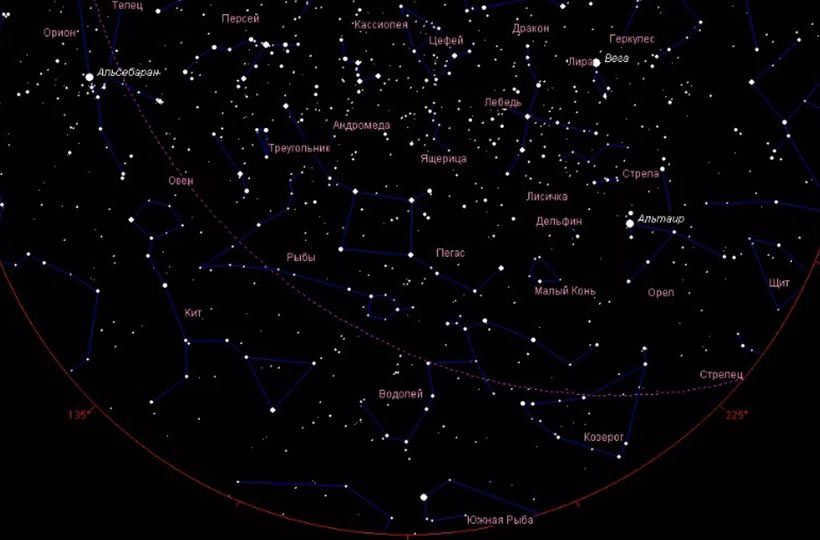
- Natal Astrology
- Relationship Astrology
- Self Development and Psychology
- Predictive Astrology
- Horoscopes and Predictions
- Talismans
- Soul Formula
- Numerology
- Astrological Tarot
- World Astrology
- For beginners
- For professionals
- Astrologer Development
Read 13 minutes min
What are these constellations? The constellations of autumn are a remarkable collection of stars that can be easily identified even without the use of a telescope. During this time, Aquarius, Aries, and Pisces are the most notable constellations, along with the Perseus family, which includes Andromeda, Cassiopeia, Pegasus, Triangle Whale, and Cepheus.
When is the best time to search for these constellations and what methods should be used? These particular constellations can be observed in the northern hemisphere from September to December and in the southern hemisphere from March to June. They can be easily identified due to their distinct shapes: Pegasus forms a large square, Cassiopeia resembles the letter W, and Lacerta creates a zigzag pattern.
A mesmerizing image of the autumn night sky
The night sky takes on a unique appearance during the fall season. With the days becoming shorter and shorter, a captivating frozen sky effect emerges: as twilight sets in, the same intricate patterns are mirrored in the celestial expanse. It is interesting to note that most of these star clusters are traditionally associated with summer in astrology. However, true autumn constellations only come into view after midnight, when observing the heavens in September. By October, they can be glimpsed in the southern part of the sky about 3-4 hours after sunset, and in November, they appear just 2 hours after darkness falls.
In September, you can easily spot 10 constellations, including Eagle, Swan, and Capricorn. These constellations are home to various celestial objects. One of them is the Dumbbell Nebula, which is concealed within the Foxy constellation. This nebula has a fascinating shape that resulted from the explosion of its outer layers, resembling a sports shell or a sideways hourglass. Additionally, these constellations contain star clusters, some of which are particularly bright. For instance, Altair, a well-known star, holds the 11th position in terms of brightness and is situated within the Eagle constellation. Another star, Deneb, plays a role in the Summer-Autumn Triangle asterism.
The constellations that can be observed in the sky during the fall month of September are as follows:
- Eagle;
- Dolphin;
- Swan;
- Capricorn;
- Lesser Horse;
- Indian;
- Arrow;
- Peacock;
- Microscope;
- Fox.
Constellations in the month of October
During the month of October, various constellations can be observed in the autumn sky. Two notable constellations are Aquarius and Pegasus. Aquarius displays two globular clusters and one open star cluster, while Pegasus contains one globular cluster. Additionally, the October sky features Alnair, the brightest star in Crane, and Fomalgaut, the brightest star in South Pisces.
The constellations that can be seen in the sky during the fall season in October include:
- Aquarius;
- Crane;
- Cepheus;
- Lizard;
- Pegasus;
- Octanthus;
- Southern Fish.

November’s Constellations
Which constellations can we spot in the autumn sky during the month of November? Out of the six constellations that dominate November’s night sky, Andromeda, Cassiopeia, and Pisces stand out as particularly noteworthy. Andromeda, the first of these constellations, contains a spiral galaxy that shares its name. This galaxy is renowned for its impressive size, as it is considered the largest spiral galaxy and is also located in close proximity to our own Milky Way. Cassiopeia, on the other hand, features two star clusters within its structure, while Pisces presents us with a “facing” spiral galaxy. As for the remaining constellations, they mainly consist of interesting individual stars.
The Square of Pegasus
In the autumn sky, there is a prominent formation known as the Great Square of Pegasus. This square is made up of four stars of second magnitude and can be easily seen in the southeastern part of the sky during September. As autumn progresses, the square rises higher in the sky and can be seen on the southern side, appearing almost parallel to the horizon. Even in urban areas, these stars are quite visible and can be compared in brightness to the stars in the bucket of the Big Dipper.
The Great Square of Pegasus gets its name from the fact that three of the stars that form it are part of the Pegasus constellation. The star that forms the upper left corner of the square actually belongs to the Andromeda constellation. Because of this, the square of Pegasus is not considered a constellation itself, but rather a well-known asterism.
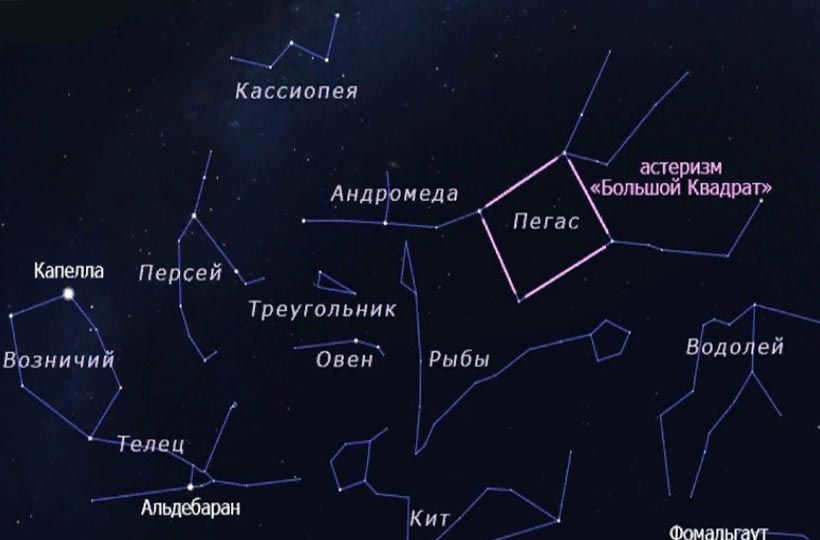
The stars in Pegasus Square and their names
Each star in the square has its own unique name. Sheath, also known as beta Pegasus, is a self-luminous celestial object located in the upper right corner. Sheath is a distant red giant and a notable semi-regular variable star.
Markab (alpha Pegasus) is situated in the lower right corner of the square. It is a distant white giant belonging to the B9III spectral class.
Algenib (gamma Pegasus) can be observed in the lower left corner. It is a high luminosity hot subgiant and the most remote star in the quadrant, positioned approximately 400 light-years away.
The last star in the upper left corner is called Alpheratz, which is a hot star of spectral type B. It is situated at a distance of approximately 100 light years.
The names of the stars in the Pegasus Square were assigned during the Middle Ages in Arab nations. Nowadays, it is quite challenging to determine their exact meaning. For instance, Markab can be interpreted as a ship, wagon, or saddle. The name Algenib may have originated from the term al janah, signifying wing, or from al janb, representing side.
The Tale of Pegasus and Andromeda
Amongst the many constellations that grace the night sky in fall, none are more captivating than Pegasus and Andromeda. Pegasus, the winged horse, and Andromeda, the princess, are a celestial duo that never fails to capture the imagination. Pegasus is comprised of three stars that form a majestic square, while Andromeda is adorned with a dozen celestial bodies that lie to its right. Unfortunately, amidst the urban lights, these stellar wonders often go unnoticed.
What truly sets the autumn constellations apart is the presence of some remarkably bright stars. One such star that demands attention is Epsilon Pegasus. Positioned to the right of the Square’s base, near the constellation of the Lesser Horse, Epsilon Pegasus shines with a brilliance that rivals the celestial bodies within the Square. Occasionally, this captivating star experiences a significant increase in luminosity, making it the most radiant luminary in all of Pegasus.
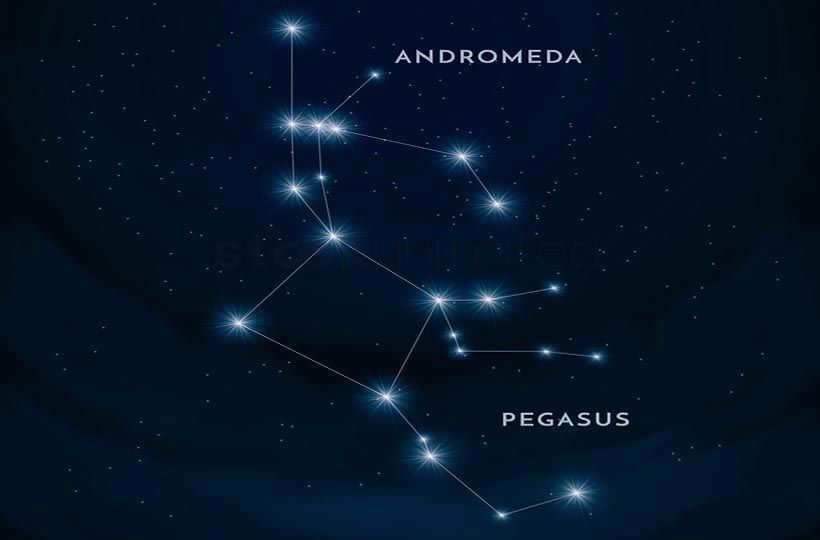
As mentioned earlier, in the top left corner of the square is the star Alpheratz, which serves as the alpha star of the Andromeda constellation. Other stars in this constellation, known for their brightness, form a broken chain that starts from Alpheratz and extends to the left and slightly above.
First in the chain is Andromeda Delta, which is considered the dimmest star. In the middle is Mirach, also known as beta Andromeda. It is of particular interest because the famous Andromeda galaxy is located just above it. The end of the chain is marked by Andromeda gamma. Alamac is a remarkable double star that can only be fully appreciated with the help of a telescope.
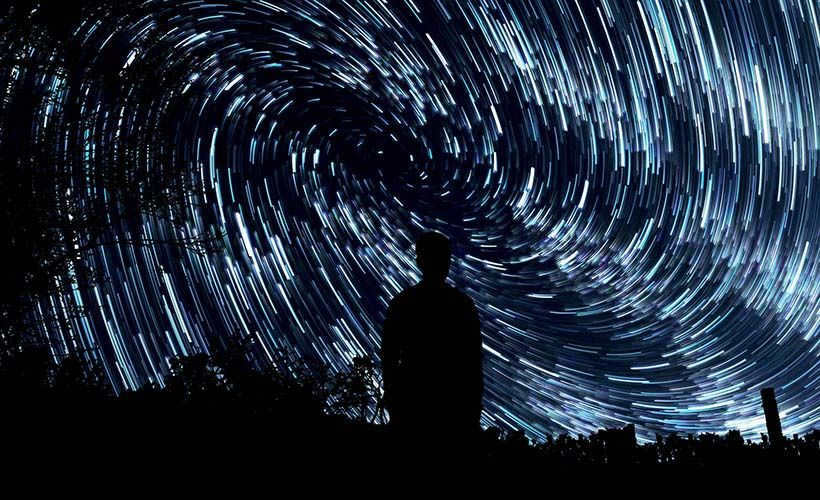
Andromeda is home to countless stars, but they are virtually invisible amidst the bright lights of the city. To urban observers, the Andromeda constellation appears as a protrusion linked to the square of Pegasus on the left. When viewed together, they create a shape reminiscent of a Turkish pipe or a tobacco pipe.
The Perseus constellation
In the autumn sky, you can locate the Perseus constellation in the northeastern region. It is easily visible as the night sets in and is not positioned too high. To spot it, simply look below the prominent Cassiopeia constellation, which has a distinct curved shape. Perseus is situated in the backdrop of the Milky Way and can be clearly seen, despite lacking any particularly bright components.
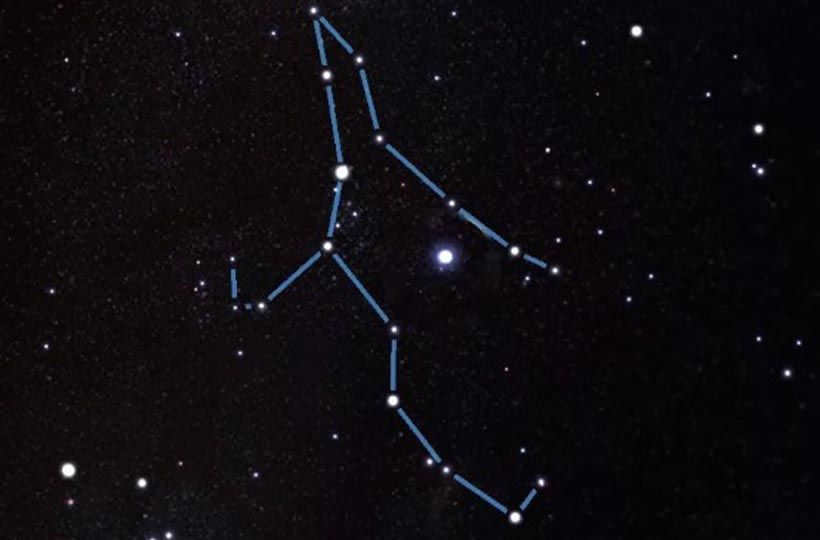
The autumn sky is home to the constellations Perseus and Andromeda, which can be seen side by side. Andromeda is located on the right, while the Great Square of Pegasus is clearly visible to the right. On the left of the square is the Ascendant constellation, which features one of the brightest stars in the Universe, Capella.
Perseus spans over 600 square degrees in the sky and contains approximately 90 stars that can be observed even without a telescope. In Russia, this cluster of celestial bodies can be seen for most of the year, except for the months of May and June. The best time to observe Perseus is in November and December, although it can be conveniently observed starting from August.
Constellation Cassiopeia
The constellation Cassiopeia can be seen best in the night sky in the shape of a non-uniform letter W or M. It consists of five stars, and is often referred to as the Throne: the magnificent Cassiopeia, depicted with a mirror, sits proudly upon it.
Cassiopeia is located near Polaris, which is why it is visible throughout Russia all year round.
However, the optimal time to observe objects within Cassiopeia using a telescope is during the autumn season. During this time, around midnight, the constellation is closer to the zenith. Specifically, at the end of September, Cassiopeia is at the latitude of Moscow.
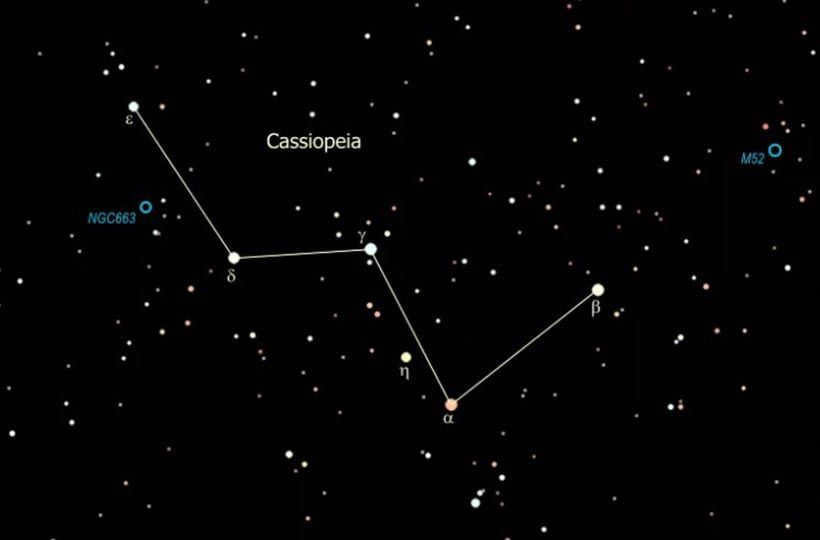
During autumn days, the sky typically offers clear views of various constellations. A prime example is Cassiopeia, which consists of five prominent stars that are easily visible even in urban areas with bright lights. These stars are sufficiently bright and are arranged in a recognizable pattern. Each of these celestial objects has its own designated name:
- Alpha Cassiopeia is known as Shedar;
- Beta Cassiopeia is referred to as Kaf;
- Gamma Cassiopeia is called Navi;
- Delta Cassiopeia is known as Rukbach;
- Epsilon Cassiopeia is labeled as Seguin.
Other celestial bodies appear much dimmer in comparison and are often not connected by lines. However, the brightest ones can still be distinguished without the need for specialized equipment. These stars are typically designated with Greek letters.
The more prominent nebula in the backdrop of the constellation diagram is the famous Milky Way.
Observing the Milky Way can be challenging within city limits, but by locating the constellation Cassiopeia, you can estimate its general position and attempt to view it.
The constellations Pisces, Cetus, South Pisces, and Aquarius
Within city limits, beneath the Great Square of Pegasus, a vast expanse of starless sky is revealed. However, within this area, the Moon is frequently visible, and occasionally, other planets can be spotted as well. This area corresponds to the zodiac constellation Pisces.
It can only be clearly observed in a dark sky devoid of lunar illumination. It appears most stunning in the absence of light pollution. Its distinguishing feature is the Ring asterism and a meandering chain of faint stars that points towards the eastern hemisphere.
The Whale constellation is situated beneath Pisces. It derives its name from the legendary sea creature that Perseus saved Andromeda from. This assemblage of stars is immense in size, yet it harbors only a solitary celestial entity of moderate luminosity. Under optimal weather conditions, one can discern nearly a dozen 3rd magnitude stars within this constellation.

Let’s go back to examining the Great Square of Pegasus. Try visually extending the right side of the asterism downwards, towards the horizon. If you are located at the latitude of Moscow or slightly further south, you will spot a relatively bright star at the bottom. This star is Fomalhaut, which represents the alpha star of the Southern Fish constellation. It is also known as a solitary star, as it is situated in the sky away from other first magnitude stars.
Between Fomalhaut and Pegasus Square, to the right of the Pisces and Cetus constellations, lies the Aquarius constellation. It is a rather faint celestial object, and it can be challenging to discern any distinct patterns within it.
The constellations Aries and Triangle
Let’s take a look at the remaining autumn constellations. Aries and Triangle can be found near the stars of the Andromeda constellation. To locate them, you can align yourself with the constellation Whale, as they are directly above it.
Triangle bears a resemblance to the geometric shape it is named after. One interesting feature of this constellation is that it contains the M33 galaxy, also known as the Triangle Galaxy. Together with the Andromeda Nebula and the Milky Way, it forms part of our local group of galaxies.
Aquarius, Pisces, and Aries are constellations that make up the zodiacal circle. This signifies that the trajectory of the Sun, Moon, and other planets passes through these constellations. For instance, Uranus will be positioned in Aries until 2024. Every month, our planet’s satellite traverses these groups of stars.
It is important to note that it is feasible to acquaint oneself with the celestial sphere at any point throughout the year. The categorization into seasons is, of course, arbitrary.
“Stellar” avians and creatures
During this time frame, you have the opportunity to explore the constellations of the autumnal firmament. It can be an enlightening experience for young individuals to acquaint themselves with mythical figures such as Perseus, Andromeda, and Cassiopeia. Additionally, they can discover fascinating “stellar” creatures like the mythical Pegasus, the curly-haired Aries, the diminutive reptilian Lizard, as well as the marine beings Whale and Fish.
The most radiant observable constellations in the autumnal sky include Cassiopeia, Pisces, Pegasus, and Andromeda. These four celestial patterns are particularly visible in clear nighttime conditions during the fall season.
The most prominent constellations and stars in the autumn sky
Among the myriad of celestial objects that grace the autumn sky, one of the most striking is Pegasus. This winged horse constellation, which takes the form of a square, is particularly prominent during this time of year. Pegasus is composed of four of the brightest stars in the sky, each with its own Arabic name: Sheat, Makrab, Algenib, and Alferatz.
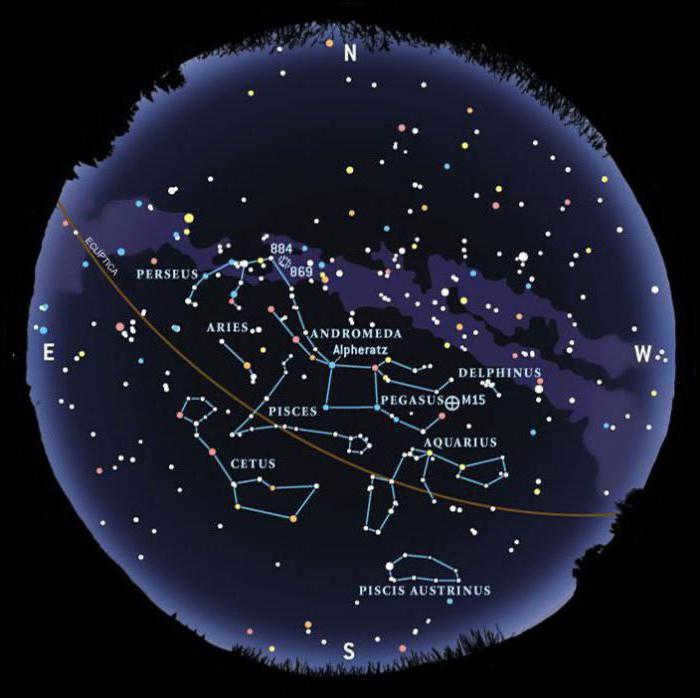
The fall sky is home to various constellations and stars, including one called Pegasus. This constellation features a unique handle that is made up of three bright stars that appear to emerge from the upper left corner of a square shape. Two of these stars, Alamac and Mirach, even have their own names. It’s interesting to note that when you look at the square and handle together, they bear a resemblance to a smaller version of the Big Dipper, which is located within the constellation Ursa Major. Additionally, the objects that make up the “pen” of Pegasus are also connected to the constellation Andromeda.
The constellation Pegasus is accompanied by Andromeda, which resembles an inverted “A”.
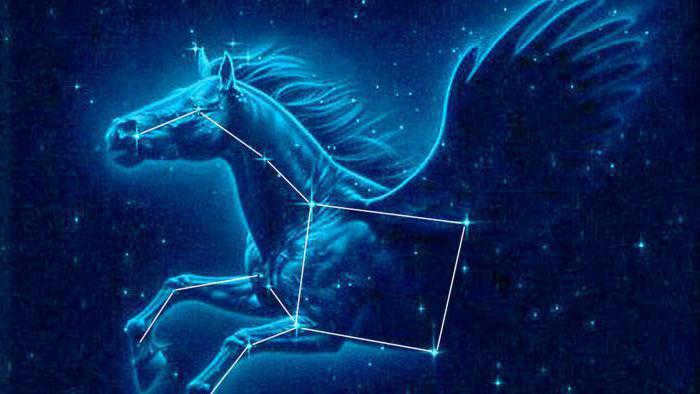
In the month of November, it is the best time to observe Andromeda in the northern hemisphere. This group of stars in the night sky includes the nearest galaxy, M 31, which can be clearly seen.
The Andromeda galaxy, also known as “M 31”, is classified as a spiral galaxy, just like our Milky Way. It is located around 25,000 light-years away from our planet Earth. This galaxy can be seen with the naked eye as a bright spot on a clear night.
Cassiopeia – an Age-Old Constellation
Located in the northern part of Andromeda, Cassiopeia is a prominent celestial formation with a long history. This ancient group of stars has been recognized since ancient times. As per the mythological tales, Cassiopeia was revered as the queen of Ethiopia. Spotting this constellation is quite straightforward. The autumn nights present the best opportunity to observe this stellar pattern. Comprising of five brilliant stars, Cassiopeia somewhat resembles the letter “W” in English.
The missing constellation of Pisces
The constellation of Pisces is symbolized by a pair of “fish”. They are separated into north and west, connected by one point in their tails. The Pisces constellation is slightly more challenging to spot compared to Cassiopeia, due to the greater scattering of stars in the observed area of the night sky. It features a group of stars with lower luminosity. Its shape resembles a “V” and borders the square of Pegasus and the Aries asterisk.
These are not the only constellations visible in the autumn sky. There are numerous beautiful and enigmatic celestial objects to observe during this time of year.
The second Sun in the constellation of Cetus
Located within the star sign of Pisces is the constellation of China. While it may not contain any particularly bright stars, it is home to a fascinating long-period variable star known as Mira Kita. At times, Mira Kita shines with a brightness that rivals the luminaries of Pegasus, only to disappear from view at other times. Another noteworthy feature of this constellation is the star T Kita, which shares similar physical characteristics to our own Sun and is one of the closest stars resembling our solar luminary.
In the fall sky’s southeastern region, there exist a duo of intriguing entities – Aries and Perseus.
Directly under the handle of Andromeda, two stars can be seen distinctly. These stars represent the most prominent features of the Aries constellation.
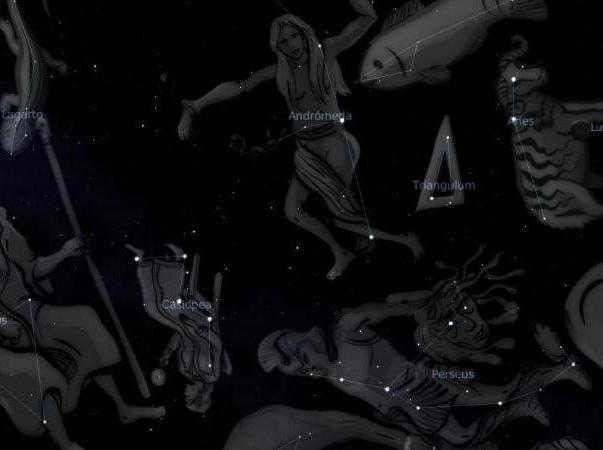
Sheratan and Hamal are the names given to them. The remaining Aries luminaries are quite faint and often go unnoticed.
The Perseus constellation contains the brightest star, Mirfak, which is its alpha. It is also considered the most prominent among all the constellations in the fall sky. Additionally, it is home to the double cluster of Hee and Ash, which are one of the most captivating clusters in the sky.

